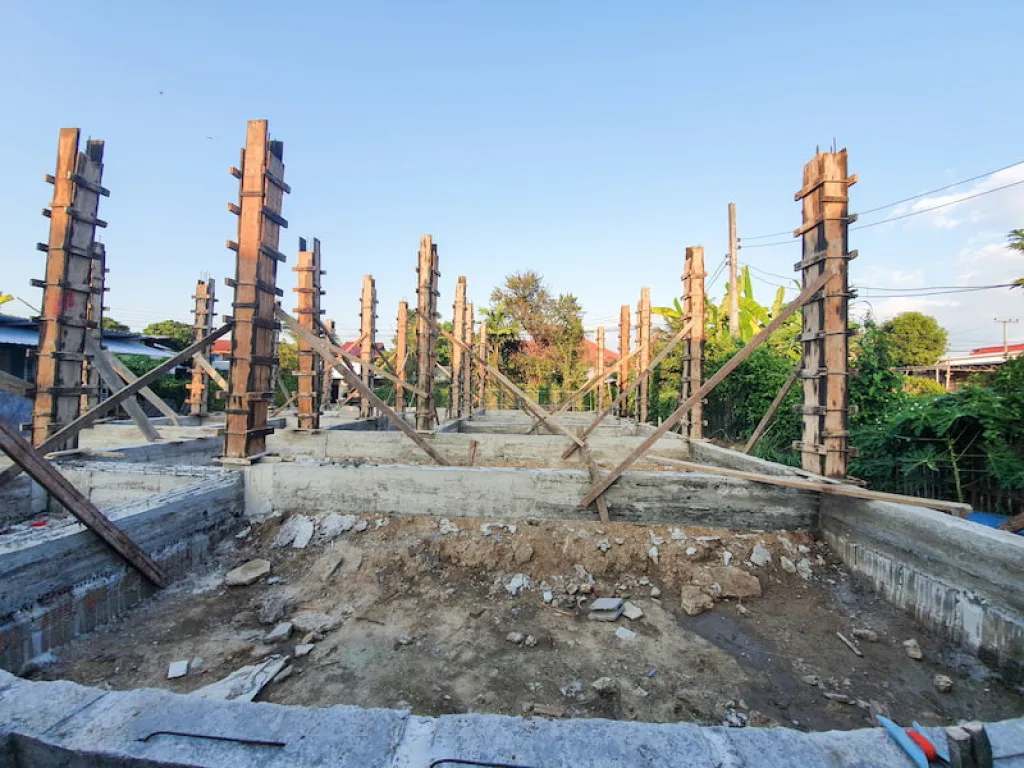A foundation is a part of a building's structure that lies at the very bottom, serving to support the entire structure.
Before starting to build a house or other structures using unique and innovative building materials, it’s essential to understand the types of foundations to support the construction. A foundation must match the type of building to adequately bear the load.
There are two types of building foundations, which are deep and shallow foundations. This article provides information on the types of building foundations in construction. Let’s dive into the complete overview below.
Types of Deep Foundations
Deep foundations are typically used for buildings in areas with specific soil conditions. This type of foundation is installed by penetrating the ground to a depth of at least 3 meters.
Deep foundations are ideal for structures with wide layouts. Below are some commonly used types of deep foundations:
1. Bore Pile
The first type of deep foundation is a bore pile. This foundation has a shape like a long tube that is driven into the ground.
Typically, a bore pile foundation is used to maintain the stability of multi-story buildings or structures near slopes.
Installing a bore pile produces much quieter noise compared to other types of foundations, thus not disturbing the surrounding environment.
Additionally, using this foundation does not alter the structure of uneven ground, making it an ideal choice for areas with irregular soil conditions.
2. Caisson
A caisson foundation combines two methods: shallow foundations and pile foundations. The name resembles its construction process that involves the creation of several wells tailored to the type of building construction. To strengthen the structure, concrete piles are embedded in the wells as the main support.
In Indonesia, caisson foundations are common for various buildings as they are suitable for hard soil. They are typically installed at depths exceeding 3 meters into the ground.
3. Pier Foundation
Pier foundations play a crucial role in transferring heavy loads from the building structure. Installation involves digging the soil to a predetermined depth, and then embedding the foundation into the dug hole.
The material commonly used for pier foundations is precast concrete. On top of the foundation, a diaphragm concrete beam is installed, adjusted in height to the foundation.
Read also: 3 Factors That Can Reduce the Quality of Mortar
4. Basement
A basement foundation is a solution to optimize limited land. This foundation consists of one or more levels below ground, allowing for the maximum use of underground space. The basement foundation consists of three parts: retaining walls, dewatering, and construction methods.
Each of these elements has its function to ensure the foundation can adequately bear and distribute the load. This keeps the foundation solid and strong to support the building.
5. Piling
The last type of deep foundation is piling. This foundation has good durability because its framework can resist decay and rust.
Although relatively expensive, this foundation is made of robust materials, making it worth the cost. Several types of piling foundations include concrete piles, steel piles, and wooden piles.
Types of Shallow Foundations
Shallow foundations are an ideal choice for buildings that are not too heavy or tall. Typically, this foundation is used in houses that do not have large structural loads.
Additionally, this type of foundation is suitable for stable soil with installation depths of no more than 3 meters. Below are some commonly used types of shallow foundations:
1. Pad Foundation
A pad foundation is common for buildings with a round or circular shape. However, this foundation may also come in a square shape.
Pad foundations are useful to support a single load in a building. This type of foundation is also ideal for use on soft soil.
Some advantages of this type of foundation include its simple design, effective load distribution across the building, and suitability for shallow areas.
On the other hand, its drawbacks include vulnerability to earthquakes, a lengthy construction process, and limitations to narrow areas.
Read also: Protect Your House with These 3 Fire-Resistant Building Materials
2. Isolated Footing
Isolated footing is popular for multi-story buildings. This foundation is only used to support the load on the columns, while the walls are supported by surrounding beams. Additionally, it also functions as the primary structure in multi-story buildings.
The cost of this type of foundation is relatively cheaper compared to others. Additionally, this foundation can be applied to various soil types, including those with low bearing capacity.
However, this type of foundation is prone to cracking, especially if the soil shifts. It also appears plain, making it less attractive compared to others.
3. Spider Web Foundation
The next type of shallow foundation is the spider web foundation. This foundation falls under the category of shallow foundations and uses the ground as its structural strength. This type of foundation has a web-like shape, resembling a spider web, as it is circular and interconnected.
Spider web foundations are typically used for buildings with light loads, such as single-story residential houses.
The advantages include easy application and minimal material requirements. However, the disadvantages include unsuitability for unstable soil and vulnerability to earthquakes.
4. Raft Foundation
Raft foundations, also known as mat foundations, are a part of shallow foundations. It can support the load of buildings with an elongated shape.
This type of foundation generally comes in elongated shapes, such as rectangles, trapezoids, and squares. The materials typically used include plain concrete, river stone, and broken stone.
Some advantages of this foundation are its ability to support weight well, suitability for soil with moderate bearing capacity, quick and easy construction process, and relatively low building costs.
However, its drawbacks include vulnerability to earthquakes, unsuitability for soil with low bearing capacity, and the need for a large area during construction.
This concludes the information on the types of building foundations in the construction world. Foundations are the most crucial part that must be carefully considered.
Therefore, it is essential to choose high-quality materials for the foundation to ensure it remains strong and sturdy.
Considering a construction project? Choose a high-quality cement for the best results!
When you’re in the construction phase, selecting high-quality cement for construction materials like foundations is a critical step. Semen Merah Putih offers the latest innovations in cement products with advanced technology.
We are committed to providing the best construction solutions for professionals and the public, through our concrete and Portland Composite Cement products, to create stronger and more durable buildings.
Contact us now to get more information about Semen Merah Putih products and get the best construction solutions for your project.
Read also: 3 Advantages of Lightweight Bricks as Building Materials



